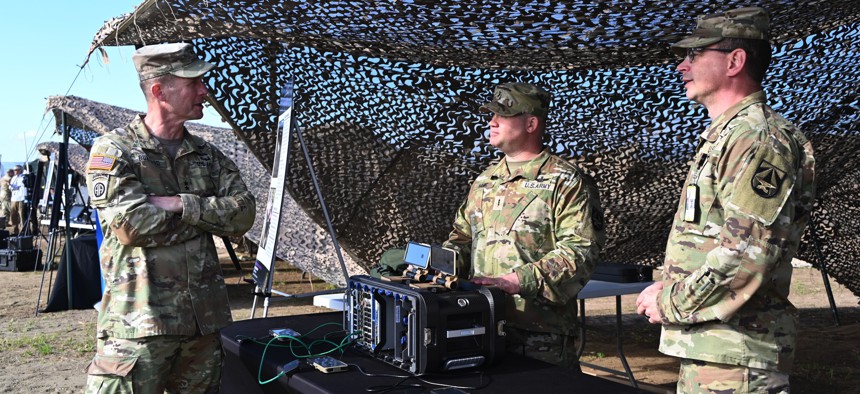
Maj. Gen. Curtis A. Buzzard, commander of Fort Moore and the U.S. Army Maneuver Center of Excellence, speaks with demonstrators from Army Futures Command about modern power consumption demands during Project Convergence Capstone 4, March 5, 2024. U.S. Army / Sgt. Nathan Smith
Targeting time shrinks from minutes to seconds in Army experiment
The latest edition of Project Convergence streamlines processes and adds new tech.
CAMP PENDLETON, California—Soldiers found targets in a tiny fraction of the normal time by streamlining procedures and speeding up data processing during a recent experiment, Army officials said Tuesday.
The Army is seeing a “two orders of magnitude” increase in the speed at which data is passed to weapons crews since the first Project Convergence, said Alex Miller, a senior science and technical advisor to Army Chief of Staff Randy George. In certain cases, processes that previously took minutes took just seconds, Miller said during a media day for this year's Project Convergence, one of the service’s marquee technology-testing events.
Miller said the success was due in part to simplifying procedures.
“A lot of it was just making sure we didn’t over-classify things,” allowing soldiers to send information to foreign partners and other services without routing data through a human, he said.
The Army also tried a “kanban”-like system for targeting, which provides a shared view of information and tasks instead of the laborious system of PowerPoint slides and dashboards usually used to share targeting data, Miller added. Kanban processes are frequently used in software development to encourage collaboration.
Systems used in the experiment were “able to pass an amount of data that we had not seen before,” said Lt. Gen. Ross Coffman, deputy commander of Army Futures Command.
Miller also said the Army made use of the Tactical Intelligence Targeting Access Node (TITAN) targeting station and the Army’s Aerial Reconnaissance and Targeting Exploitation Multi-Mission Intelligence System (ARTEMIS) jets. On Wednesday, the Army announced it awarded Palantir with a $178 million contract to deliver 10 TITAN prototypes.
Project Convergence began in 2020 as a way to test experimental Army technology, from artificial intelligence to robotics. In the years since, the Army added in other services, as well as other countries, like Australia and Great Britain.
The event also became a critical way to evaluate the technology and processes designed to quickly share data across services and between nations. The connect-everything concept and related technology is known as Combined Joint All-Domain Command and Control, or CJADC2.
The Defense Department recently launched an initial version of the CJADC2 capability, Deputy Secretary of Defense Kathleen Hicks said Feb. 24. That version is now being tested at Project Convergence, which ends March 20.
Military leaders see sharing targeting data as particularly vital in battles where all services are engaged in tracking and firing on enemy forces.
Services and allied nations all have some form of long-range intelligence collection, and have weapons they can use based on that intelligence. But unless they share information, multiple units could dogpile on the same target—or else waste precious time determining who will fire what.
“If we can't connect ourselves together, then we're going to build individual stovepipe plans,” said Vice Adm. Michael Boyle. “And we may end up double targeting or triple targeting.”
Data sharing will also help ensure the military doesn’t waste its missiles. That has become a key consideration following a think tank analysis that shows the U.S. would struggle to produce enough long-range precision missiles for a protracted war.
“With that common operational picture, we’ve identified the one shooter so we don’t waste missiles needlessly,” said Coffman.
China and Russia are also working on systems to quickly distribute intelligence to military units. China is developing a concept called Multi-Domain Precision Warfare, while Russia has dubbed its version Automated Control Systems.
Even without advanced network-based targeting, Russian targeting can be swift and deadly, with Russian forces honing their skills over two years of intense combat in Ukraine. Thanks to their reconnaissance drones and other targeting tools, some Russian artillery crews can target Ukrainian positions within three minutes of spotting them.
The speed of the U.S. targeting process is competitive with adversaries, Miller said. But potential adversaries have so many missiles in their stockpiles that the U.S. must focus on knocking out enemy launchers rather than shooting individual missiles out of the air, Coffman said.
“We need to ensure that offensive fires would defeat their capabilities on the ground, so that we're not trying to shoot things out of the air, but rather shooting them before they get into launch,” Coffman said.




